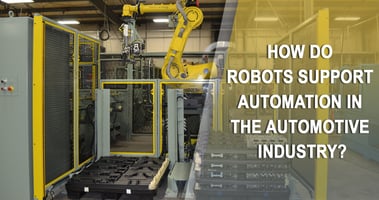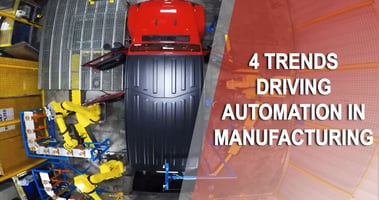When it comes to leveraging robotic applications to enhance automated operations, the automotive...
How Industrial Automation & Robotics Reduce Costly Errors

The International Federation of Robotics (IFR) estimates that just three years ago, there were approximately 2.1 million stand-alone industrial robots installed worldwide, with the largest applications including manufacturing operations such as machine tending, welding, soldering, and assembling materials. In addition, analysts have predicted strong future growth of collaborative robots throughout 2020 and beyond.
There’s a host of reasons why forward-thinking, growth-driven organizations have been integrating automation and robotics within their manufacturing operations, not the least of which is the capacity to significantly reduce human errors that eat away at a company’s bottom line.
Manufacturing automation and robotics streamline repetitive tasks and minimize margins of error, contributing to major cost savings for those who embrace the technology wisely. The adoption of these advanced systems has become a critical solution to manufacturers’ quality, consistency and safety issues.
Read on to gain a better understanding of how this is playing out in a number of manufacturing environments across various industries.
5 Ways Human Error Impacts Manufacturing Profits
Following are some of the most notable ways a manufacturing company can experience profit loss stemming from the limitations and fallibilities of human workers.
1. Production Downtime
Decision-makers in the manufacturing world understand all too well that unplanned downtime is an expensive reality. Studies indicate that 82% of companies have experienced unplanned downtime over a three-year period, costing up to $260,000 per hour.
2. Product Contamination
Particularly in the food and beverage industry, production and handling processes that rely on human workers carry increased risk of introducing contamination into the environment, which ultimately endangers the final product. Contamination by germs, pathogens or foreign objects can amount to serious expenses in the form of discarded food, complex recall processes, loss of consumer trust and legal liability.
3. Insufficient Repeatability & Precision
Especially when it comes to manufacturing in the pharmaceutical and healthcare arenas, human error is a big concern. It is essential for these products to have zero defects. There’s simply no other option when people’s health and lives are at stake. Without the support of automated solutions that make ultimate repeatability and precision a reality, there’s serious risk to both consumers and the organization at large.
4. Unnecessary Waste
When it comes to applications that involve uniformity and quality, human error has the potential to incur substantial monetary losses. Consider, for instance, companies in the faucet industry that utilize workers to fulfill the polishing process. Because humans, by nature, are prone to making mistakes, a certain amount of products will bear defective surface finishes and must be discarded.
5. Material Damage & Safety Risk
In industries where expensive materials and equipment are handled by humans, there’s ample opportunity for human error to result in costly damage and even injury. Fiber optic cable, for example, is extremely fragile. If mishandled by a worker, it can cost thousands of dollars—a pricey mistake, to say the least. Or, if a heavy part is dropped and hurts someone, there are the costs of personal injury and liability with which to contend.
How Industrial Automation and Robotics Answer the Call
By integrating industrial automation and robotics systems into your operations, you gain the competitive advantage of diminished human error. Consider that:
- An automated machine doesn’t tire or lose focus.
- A robot isn’t prone to dropping items, getting distracted or forgetting a step in the process.
- Multitasking is far more efficient and accurate when managed by a programmable machine than by a worker with human constraints.
These solutions make uniformity and quality vastly more attainable in all types of production environments. They also promote efficiency and enable companies to make smarter decisions based on the limitations of their human workers.
This approach can be especially valuable at factories and mills where air quality, temperature requirements, and/or proximity to sharp, hot, or dangerous objects make for unsafe working conditions. When you replace these worker functions with those that can be operated by robots, you decrease the risk of safety hazards to human life.
What Automation Trends Predict for the Future of Manufacturing
Particularly amidst the challenges introduced by Covid-19 to consumers and organizations across the globe, the need for manufacturing efficiencies, high standards of quality control, and a laser focus on personal safety is becoming increasingly apparent. For this reason—and because of the significant competitive advantages afforded by automation even before the world faced a life-changing pandemic—the manufacturing industry is leaning into automated and robotic solutions more than ever before.
“More and more manufacturers are leveraging robotic automation for a wider number of applications,” explains the Robotics Industries Association. “Late adopters, who would clearly benefit from automation, are looking for answers to their questions: Are robots too expensive for our business? Is our business too small to make use of robotics? Are robots difficult to program and operate? Will robotics cost human workers their jobs? The simple answer: No.
“Robots allow manufacturers to lower costs and bring jobs back to the United States, resulting in more jobs for U.S. workers. Robots also protect workers from having to do repetitive, mundane, and dangerous tasks that could negatively impact their ability to work. Robotic automation offers manufacturers growing opportunities to save on costs, enhance production, and remain competitive. The return on investment can equal growth that not only increases profits but creates jobs for a community and savings for customers.”
As the technology of automation in manufacturing continues to advance, so do the advantages of leveraging such opportunities in facilities across the industry. It is the way forward for organizations focused on minimizing human error, reducing costs, and attaining the myriad of other benefits garnered through the adoption of automated solutions.
Interested in learning more about robotics and the potential for return on investment at your manufacturing company? Download your free copy of 7 Ways to Get ROI from Robotics Integration in Manufacturing.



